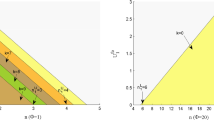Abstract
In this article, we study the dynamic pricing problem of a multi-server facility that processes requests from several customer classes on a first come first served basis. We assume an arrival belongs to one of a finite number of customer classes and that each class is distinguished by known and arbitrary service valuations and arbitrary but non-decreasing waiting cost functions. We model the facility as an M/M/S/I queue and use the theory of Markov Decision Processes to identify dynamic pricing strategies that maximize the revenues obtained from customers who are assumed to be acting individually to maximize their utility. The key to our approach is recognizing, that a single generic model can be used to understand and optimize social benefit and revenue. Through analyzing that model we can determine that the maximum revenue obtainable from a service facility is bounded by the maximum collective benefits less waiting costs that customers could receive in such a facility, which is achieved through state dependent social (welfare) optimization. For our model, we show that this upper limit can be achieved with state dependent revenue maximization when it is possible to exactly charge customers the benefit they receive less the waiting costs they incur. This in turn can be accomplished when it is possible to identify the group of customers to which each customer belongs, where customers in each group have the same benefit and waiting cost function. We also conduct a detailed numerical study to examine the value of full and partial differentiation via super-groups by comparing the resulting revenue to the revenue of a state dependent pricing policy that offers a single price to all customer groups. We demonstrate the effect of several input parameters on the revenue associated with each level of differentiation and in particular asses the value of differentiation by studying the interplay between the gross benefits and waiting costs. We find that, when customer groups with higher gross benefits have higher or lower waiting costs, partial differentiation through super-groups results in significant revenue increases over no differentiation. We also find that when customer groups with different gross benefits have similar waiting costs, forming super-groups through gross benefits is much more beneficial than forming super-groups by waiting costs. Finally, we illustrate that the revenue maximizing pricing policy might actually increase arrival rates as system occupancy increases, by admitting customer classes that were not admitted in previous states.






Similar content being viewed by others
Notes
Following our initial comment regarding the buffer size, one might argue that it could be beneficial to consider the admission of group 3 and group 4 customers even after state 25. However, the infinite horizon expected average revenue, γ, is insensitive to the buffer choice as long as the size of the buffer is large enough and the choice of 25 is without loss of generality.
References
Afeche, P. and Mendelson, H. (2004) Pricing and priority auctions in queueing systems with a generalized delay cost structure. Management Science 50 (7): 869–882.
Ata, B. and Shneorson, S. (2005) Dynamic control of an M/M/1 service system with adjustable arrival and service rates. Management Science 52 (11): 1778–1791.
Bitran, G. and Caldentey, R. (2003) An overview of pricing models for revenue management. Manufacturing & Service Operations Management 11 (3): 203–229.
Chen, H. and Frank, M.Z. (2001) State dependent pricing with a queue. IIE Transactions 33 (10): 847–860.
Dewan, S. and Mendelson, H. (1990) User delay costs and internal pricing for a service facility. Management Science 36 (12): 1502–1517.
Elmaghraby, W. and Keskinocak, P. (2003) Dynamic pricing: Research overview, current practices and future directions. Management Science 49 (10): 1287–1309.
Federgruen, A. and Tijms, H.C. (1978) The optimality equation in average cost denumerable state semi-Markov decision problems, recurrency conditions and algorithms. Journal of Applied Probability 15: 356–373.
Feinberg, E.A. and Reiman, M.I. (1994) Optimality of randomized trunk reservation. Probability in the Engineering and Informational Sciences 8 (4): 463–489.
Feinberg, E.A. and Yang, F. (2011) Optimality of trunk reservation for an M/M/k/N queue with several customer types and holding costs. Probability in the Engineering and Informational Sciences, published online 21 July 2011, DOI:10.1017/S0269964811000179.
Howard, R. (1960) Dynamic Programming and Markov Processes. Cambridge, MA: MIT Press.
Knudsen, N.C. (1972) Individual and social optimization in a multi-server queue with a general cost-benefit structure. Econometrica 40 (3): 515–528.
Lippman, S.A. and Stidham, S. (1977) Individual versus social optimization in exponential congestion facilities. Operations Research 25 (2): 233–247.
Low, D.W. (1974a) Optimal dynamic pricing policies for an M/M/s queue. Operations Research 22 (3): 545–561.
Low, D.W. (1974b) Optimal pricing for an unbounded queue. IBM Journal of Research and Development 18 (4): 290–302.
Maglaras, C. (2006) Revenue management for a multiclass single-server queue via a fluid model analysis. Operations Research 54 (5): 914–932.
Maoui, I., Ayhan, H. and Foley, R.D. (2007) Congestion-dependent pricing in a stochastic service system. Advances in Applied Probability 39 (4): 898–921.
McGill, J.I. and van Ryzin, G.J. (1999) Revenue management: Research overview and prospects. Transportation Science 33 (2): 233–256.
Mendelson, H. (1985) Pricing computer services: Queueing effects. Communications of the ACM 28 (3): 312–321.
Mendelson, H. and Whang, S. (1990) Optimal incentive-compatible pricing for the M/M/1 queue. Management Science 38 (5): 870–883.
Miller, B.L. (1969) A queueing reward system with several customer classes. Management Science 16 (3): 234–245.
Naor, P. (1969) The regulation of queue size by levying tolls. Econometrica 37 (1): 15–24.
Paschalidis, I.C. and Tsitsiklis, J.N. (2000) Congestion-dependent pricing of network services. IEEE/ACM Transactions on Networking 8 (2): 171–184.
Whang, S. (1986) The Value of System State Information in Information Systems. Unpublished manuscript.
Yechiali, U. (1971) On optimal balking rules and toll charges in the GI/M/1 queueing process. Operations Research 19 (2): 349–370.
Author information
Authors and Affiliations
Rights and permissions
About this article
Cite this article
Giloni, A., Koçağa, Y. & Troy, P. State dependent pricing policies: Differentiating customers through valuations and waiting costs. J Revenue Pricing Manag 12, 139–161 (2013). https://doi.org/10.1057/rpm.2012.17
Received:
Revised:
Published:
Issue Date:
DOI: https://doi.org/10.1057/rpm.2012.17




